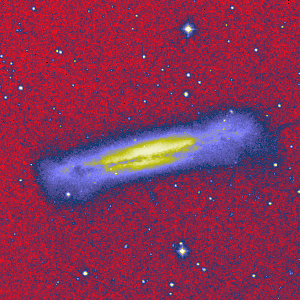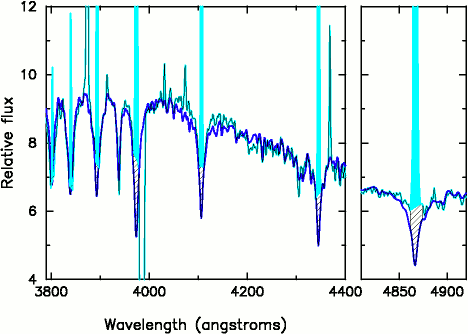Optical page

Spectra and gradients
Measuring spectral line-strengths
and their spatial variations across spheroidal systems (ellipticals,
lenticular, spiral bulges and cD galaxies). Abundance and age distributions
in stars mainly determine the spectral feature strengths in integrated stellar
populations. A major problem is dientangling the two effects of age
and abundance. This work is in collaboration with postgraduate students
and with external collaborators.
See GCE description page for details.
Above is an optical image of an edge-on, spiral galaxy, showing
emission from the disc and bulge.
GAMA-KiDS-GalaxyZoo
The Galaxy and Mass Assembly project
(GAMA) is a redshift survey carried out
at the AAT, plus multiple wavelband observation, from the UV to far-IR.
Optical SDSS images were used to
characterise the galaxies. See these fly-through movies to see the distributions and morphologies of GAMA galaxies. More recently, deeper and sharper images from the Kilo degree survey (KiDS) are being used, for finer galaxy classification of GAMA galaxies. Galaxy Zoo was used to obtain GAMA galaxy classifications from KiDS images.
SALT Observations
We have studied low luminosity, spheroidal systems (low luminosity ellipticals) and shown that their element abundance patterns are more like the Sun than those in more luminous spheroidals (such as giant ellipticals). See Sansom and Northeast 2008. One such low luminosity galaxy is NGC 59, in the nearby Sculptor group. We obtained data from the SALT telescope with the Robert Stobie Spectragraph. The plot below shows our fits to model the absorption line spectrum below the hydrogen emission lines (including Hβ, Hγ, Hδ, H7, H8, H9, and H10 at 3798 Å wavelength). See Sansom et al. 2015.

New SALT observations of the spectra of dusty elliptical and lenticular galaxies are being obtained to study their stellar populations and star formation histories. This is the current MSc project of Ron Savage.


